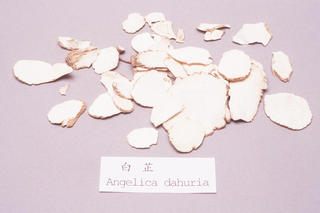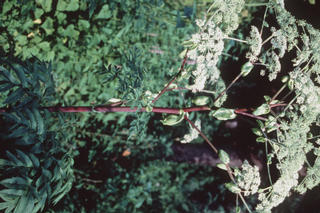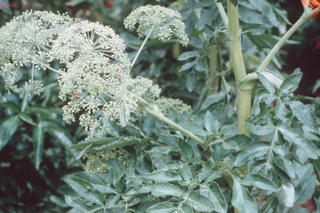Angelica dahurica var. formosana
Contents
Nomenclature
Other Names:
Historical Use of Angelica dahurica var. formosana
Angelica dahurica var. formosana in Traditional Chinese Medicine
Background
Hangbaizhi º¼°×ÜÆ
Xiangbaizhi Ïã°×ÜÆ
Chinese Name (pinyin): Baizhi
Chinese Name :
Common Name :Dahurian Angelica Root
Specific Name : Radix angelicae dahuricae
Scientific Name:
Collection : The drug is collected in summer and autumn when leaves turns yellow, removed from rootlet and soil and dried in the sun or at a low temperature.
Description : Long conical, 10 - 25cm long, 1.5 - 2.5 cm in diameter. Externally greyish brown or yellowish brown. The root stock obtusely quadroangular or subrounded with longitudinal wrinkles, rootlets scars and lenticels like transverse protrudings. Some of them arranged in 4 longitudinal rows. Apex with dented stem scars. Texture compact, fracture white or greyish white and starchy, cambium ring brown, subsquare or subrounded, scattered with many brown oil dots in bark. Odour aromatic, taste pungent and bitterish.
Identification : 1.To 0.5g of the powder add 3 ml of ether, shake for 5 minutes, allow to stand for 20 minutes. To 1 ml of the supernatant add 2 - 3 drops of each 7% solution of hydroxylamine hydrochloride in methanol and 20% solution of potassium hydroxide in methanol, mix well, heat gently on a water bath, cool, adjust to pH 2 - 4 with dilute hydrochloric acid and then add 1 - 2 drops of 1% solution of ferric chloride in ethanol, a violet red colour is produced.2.To 0.5g of the powder, add 3 ml of water, shake, filter and add 2 drops of the filtrate to a piece of filter paper. Examine under ultra violet light (365 nm), a blue fluorescence is produced.3.To 0.5g of the powder add 10ml of ether, soak for 1 hour and shake frequently, filter, evaporate the filtrate to dryness. Dissolve the residue in 1 ml of ethyl acetate and use it as the test solution. Dissolve imperatorin CRS and isoimperatorin CRS in ethyl acetate to produced a solution of each of 1 mg per ml and used it as the reference solution. Carry out the method for thin layer chromatography (Appendix Vl B), using silica gel G containing carboxymethylcellulose, sodium as the coating substance and petroleum ether (30 - 60ºC)-ether (3:2) as the mobile phase. Apply 4 µl of each of the solutions to the plate. After developing at 25ºC and removal of the plate, dry it in the air, examine under ultra violet light (365 nm). The fluorescent spots in the chromatogram obtained with the test solution correspond in position and colour to the spots in the chromatogram obtained with the reference solution.4.Total ash: Not more than 6.0% (Appendix lX K)Acid-insoluble ash: Not more than 2.0%
Processing :
Action : To dispel wind, to remove damp, to clear the stuffed nose, to relieve pain, and to promote the subsidence of swelling and drainage of pus.
Indication : headache, particularly pain the forehead, stuffy nose due to colds; sinusitis; toothache; excessive leukorrhea; swelling and pain of sores and wounds
Precautions :
Dosage : 3 to 9 g.
Storage : Preserve in a cool and dry place, protected from moth.
Synonymns for Angelica dahurica var. formosana
Patent Medicines and Medicines with Multiple Ingredients that include Angelica dahurica var. formosana
Pharmaceutical Information
Chemical Constituents
Evidence or the Use of Angelica dahurica var. formosana in the Treatment of Epilepesy
Basic Science
Animal Studies
Cohort, Case-Control and Non-Randomized Trials
Randomized Controlled Trials
Meta-Analysis
1st Five Results: pubmed search
Yijie Jiang, Yunxin Zhang, Yanan Liu, Jiaheng Zhang, Meiyan Jiang, Changguo Nong, Jinsong Chen, Kai Hou, Yinyin Chen, Wei Wu
##Title##
J Agric Food Chem: 2024, 72(13);6964-6978
[PubMed:38525888]
[WorldCat.org]
[DOI]
(I p)
Jenn-Che Wang, Hung-Hsin Chen, Tsai-Wen Hsu, Kuo-Hsiang Hung, Chi-Chun Huang
A taxonomic revision of the genus Angelica (Apiaceae) in Taiwan with a new species A. aliensis.
Bot Stud: 2024, 65(1);3
[PubMed:38252347]
[WorldCat.org]
[DOI]
(P e)
Mei-Yan Jiang, Ren-Lang Liu, Yang Zhou, Si-Qin Liu, Yun-Shu Yang, Fei Yao, Xuan DU, Yin-Yin Chen, Dong-Ju Feng, Dong-Bei Xu, Wei Wu
[Screening and promoting effect of grow-promoting fungi in rhizosphere of Angelica dahurica var. formosana].
Zhongguo Zhong Yao Za Zhi: 2023, 48(19);5172-5180
[PubMed:38114107]
[WorldCat.org]
[DOI]
(P p)
Meiyan Jiang, Fei Yao, Yunshu Yang, Yang Zhou, Kai Hou, Yinyin Chen, Dongju Feng, Wei Wu
##Title##
PeerJ: 2023, 11;e15997
[PubMed:37692115]
[WorldCat.org]
[DOI]
(I e)
Ping Wu, Xiaoyu Wang, Junxia Guo, Songli Zhang, Qingmiao Li, Mei Zhang, Qingmao Fang, Bin Luo, Hongsu Wang, Weijin He
Analysis of the difference between early-bolting and non-bolting roots of Angelica dahurica based on transcriptome sequencing.
Sci Rep: 2023, 13(1);7847
[PubMed:37188680]
[WorldCat.org]
[DOI]
(I e)


